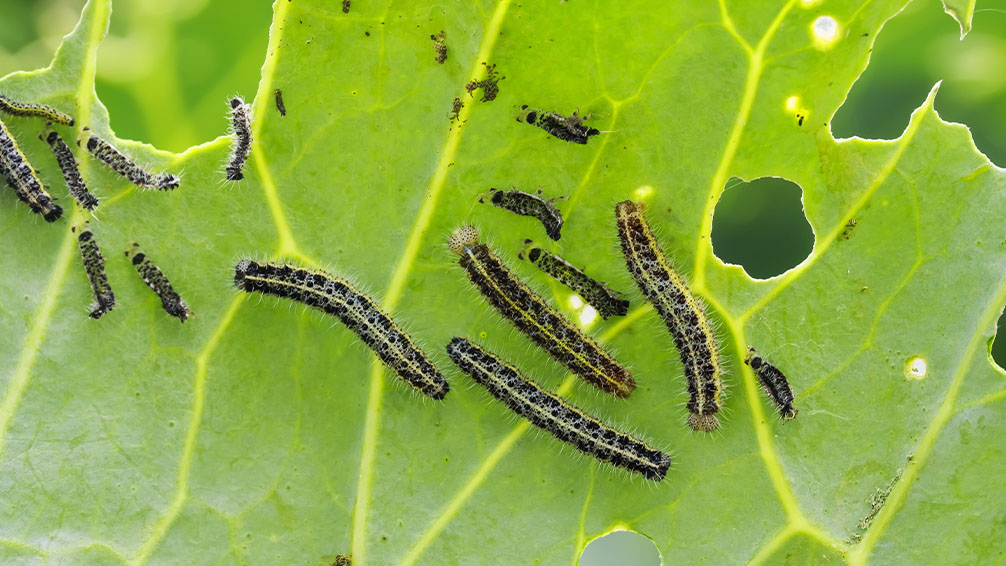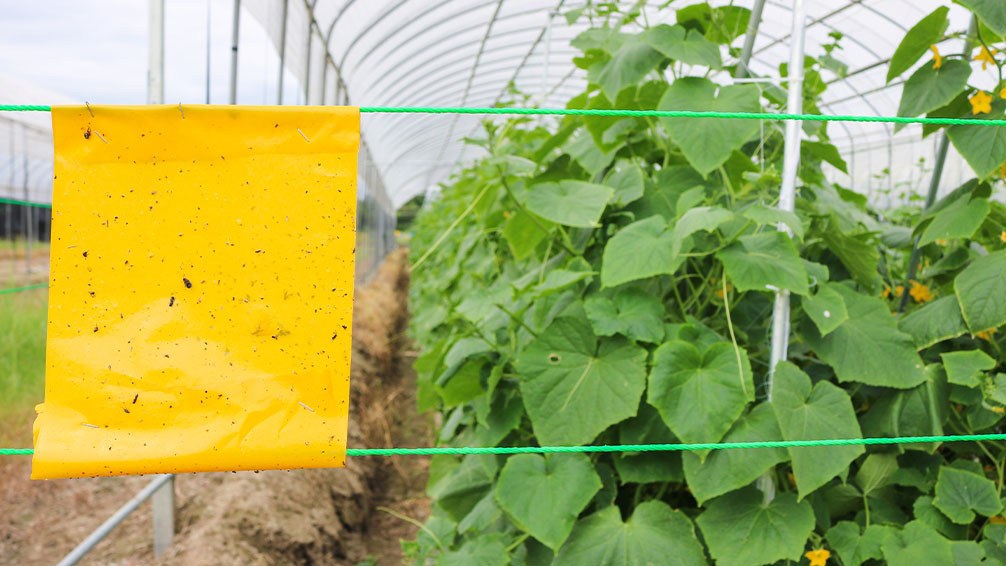
Houston’s Least Wanted: Fall Pest Control
As we kick off our fall vegetable gardening and go through our yearly fall yard cleanup checklist, it’s not uncommon to stumble upon some uninvited guests: garden pests. These plant-hungry masterminds are notoriously sneaky, concealing themselves on the undersides of leaves and building top-secret underground lairs beneath the surface of the soil.
Getting rid of these bad bugs requires you to stay on high alert for any signs of infestation, as well as having a fully stocked arsenal of anti-pest weaponry. But to protect the innocent, good bugs that help our gardens thrive, we need to choose our methods wisely! Here’s a list of Houston’s Least Wanted, plus some pro tips for getting rid of those creepy crawly criminals before they achieve total garden domination.
Prevention will also do you a world of good, so consider crop rotation, companion planting, and crop covers.
Texas Garden Pests: The Worst Offenders
You may recognize some of these common garden menaces that target our innocent vegetable plants and flowers, while others are a lot better at disguising themselves. Keep an eye out for them, or the tracks they leave behind so that you can beat them early in the game!

Cabbage Worms and Loopers: Cabbage worms and loopers got their name because they’re always stealing our cabbage! They also like kale, broccoli, and other cruciferous veggies.
The worms have just two sets of feet, so they crawl around like an inchworm, whereas the loopers are green and yellow with more legs. They often leave tiny white eggs on plant leaves, but they’re pretty tricky to spot with the naked eye. You’ll know cabbage worms have been wreaking havoc on your veggies when you see big chomp marks all over the leaves, and you may also notice some sticky “frass,” or insect droppings.
Potato Beetle: These orange and black striped beetles have huge appetites, feasting on our potato crops with the same kind of voracity as your brother-in-law at Applebees’ Half-Off Wings Night. They can lay up to 25 eggs at a time, and they’re tough as nails, so fast action is essential. You may need to employ a few different pest control methods to make sure they’re completely gone, and since they overwinter in the soil, you might want to consider planting potatoes in another spot the following year.

Cucumber Beetle: These guys have yellow bodies with either stripes or spots. The stripey ones love cucumber, melons, and squashes (cucurbit plants), while the spotty ones like those, plus a few more. They grow into adults around mid-to-late summer, so in fall, they’re usually on the prowl for food, but their larvae hang out around the roots and do all their damage underground. Signs of infestation include yellowing leaves, holes, pock-marked fruit, and sometimes they’ll even transmit bacterial wilt to your plants.
Cucurbit plants tend to be a bit sensitive, so you don’t want to use anything too chemical-heavy for pest control. Instead, use methods of manual removal (in other words, pick ’em off), and try introducing beneficial insects to eat the larvae. Prevention will also do you a world of good, so consider crop rotation, companion planting, and crop covers.
Leafminers: If you notice strange, white squiggles all over your plant leaves, you’re dealing with leafminers! They’re literally burrowing around under there, leaving a pretty obvious trail in their wake. Leafminers are actually just the larval stage of a whole bunch of different insects, and since they’re embedded in the leaves, you’ll want to use a generous coating of insecticidal spray to get them out.
Aphids: These well-known and universally loathed insects aren’t so great at covering their tracks. You’d think a criminal mastermind would know better than to leave sticky trails of waste behind wherever they go, but I guess they aren’t the brightest of the bunch. That sticky waste, called honeydew, can often lead to the development of black mold, and it occurs because the aphids are sucking up all the moisture out of your plant’s leaves and taking an excessive number of bathroom breaks. So, if you notice any of those signs (or the little critters themselves, which are super small, and either green, orange or black), get them out ASAP with a natural pest control spray. Beneficial insects like ladybugs are also great at hunting aphids, so you can also trap and release them near your most-infested plants.

Slugs and Snails: These ultra-gross bugs are pretty easy to spot because they’re big and slow, and their recommended control measures are much different than the typical backyard bug. Place a few shallow saucers full of beer around the garden, and they’ll all race towards the plate. Check the plates every day, and throw out any of the slugs or snails that fall into your ingenious trap. It also helps to sprinkle abrasive materials like eggshells, coffee grounds, or diatomaceous earth around your plants to keep slugs and snails out, because it will scratch their bellies up, and understandably, they don’t enjoy that.
Tomato Hornworms: These big, chunky worms seem like they would be easy to spot, but their bright green color blends right into plant foliage, and they tend to hang out on the undersides of leaves, so you’ll need to patrol the area regularly. They tend to like other nightshades like potatoes, eggplants, and tobacco, in addition to tomatoes. Many beneficial insects and birds like to feast on these bad boys, so it’s worth it to set up a bird feeder nearby!
The Best Pest Control Methods
Here are our favorite natural, chemical-free solutions for pest control in Houston:
Spinosad Soap Spray: Spinosad is a natural bacteria harvested in the distillation of rum. Simply spray your plant all over, wait a day or two, and then repeat the process until the bugs are gone. This is very effective for leaf minors.
Neem Oil: This essential oil is derived from the neem tree, and it’s a surprisingly powerful insect deterrent that doesn’t do any harm to our friendly neighborhood pollinators. Buy a spray infused with neem oil, or buy it pure to make your own water-based spray solutions.
Pyrethrin: This spray is all-natural and derived from the chrysanthemum plant. It messes with the central nervous system of insects and kills them, so it’s pretty effective. However, it does pose a threat to beneficial insects like bees and ladybugs, so you should only use it when absolutely necessary.

Sticky Traps: Small, hard-to-spot insects can be collected easily with sticky traps that you can hide throughout the garden.
Introduce Beneficial Insects: Ladybugs and other predatory insects can actually be purchased at our store! When they warm back up to room temperature, they wake up from their cold-induced nap and are hungry and ready to kick some bug butt.
BT Spray: Bacillus thuringiensis spray is an organic solution containing a naturally occurring bacteria that kills many of the toughest caterpillars. If you’re dealing with a really nasty infestation and don’t want to resort to chemical sprays, BT spray will work great.

Remove by Hand: Many chunky caterpillars and worms are easy to pluck off and throw into a bucket of soapy water. You can also try shaking the plant and tossing away all the worms that fall off.
The Vacuum Method: Sucking up bugs with a vacuum is a totally viable method of insect control! Just make sure you don’t accidentally suck up your plant. That would be tragic.
Got insect or fungal damage that you can’t quite identify? Take a photo and show it to us at the shop—we’ll be happy to help you spot the perpetrators! We’ve got plenty of pest control products in-store as well, so come on down to Plants for All Seasons, or call us to make arrangements for curbside pickup or home delivery.

